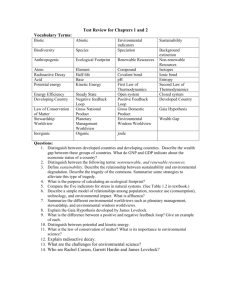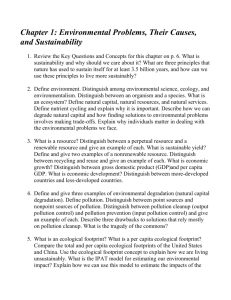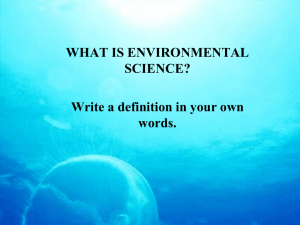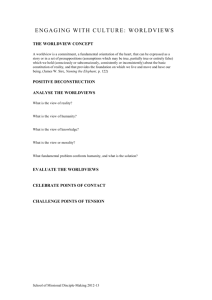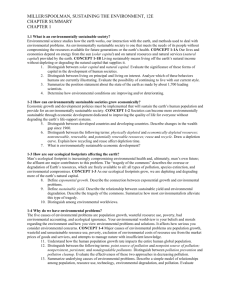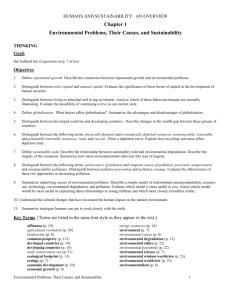Unit 1: Introduction to Environmental Science - sohs
advertisement
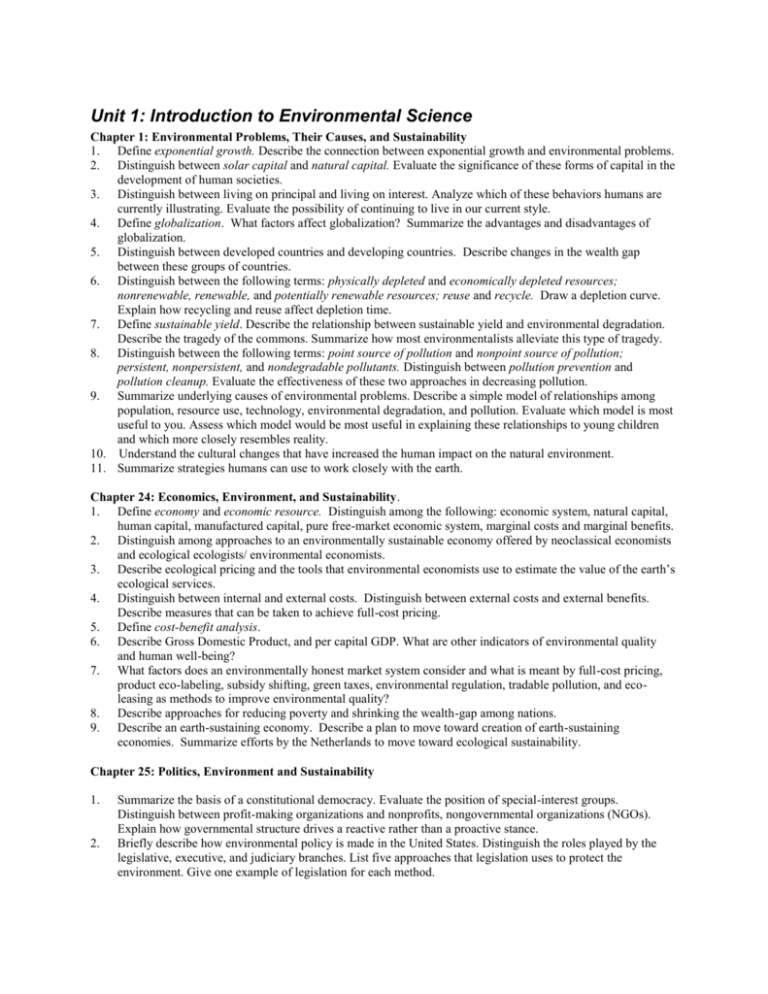
Unit 1: Introduction to Environmental Science Chapter 1: Environmental Problems, Their Causes, and Sustainability 1. Define exponential growth. Describe the connection between exponential growth and environmental problems. 2. Distinguish between solar capital and natural capital. Evaluate the significance of these forms of capital in the development of human societies. 3. Distinguish between living on principal and living on interest. Analyze which of these behaviors humans are currently illustrating. Evaluate the possibility of continuing to live in our current style. 4. Define globalization. What factors affect globalization? Summarize the advantages and disadvantages of globalization. 5. Distinguish between developed countries and developing countries. Describe changes in the wealth gap between these groups of countries. 6. Distinguish between the following terms: physically depleted and economically depleted resources; nonrenewable, renewable, and potentially renewable resources; reuse and recycle. Draw a depletion curve. Explain how recycling and reuse affect depletion time. 7. Define sustainable yield. Describe the relationship between sustainable yield and environmental degradation. Describe the tragedy of the commons. Summarize how most environmentalists alleviate this type of tragedy. 8. Distinguish between the following terms: point source of pollution and nonpoint source of pollution; persistent, nonpersistent, and nondegradable pollutants. Distinguish between pollution prevention and pollution cleanup. Evaluate the effectiveness of these two approaches in decreasing pollution. 9. Summarize underlying causes of environmental problems. Describe a simple model of relationships among population, resource use, technology, environmental degradation, and pollution. Evaluate which model is most useful to you. Assess which model would be most useful in explaining these relationships to young children and which more closely resembles reality. 10. Understand the cultural changes that have increased the human impact on the natural environment. 11. Summarize strategies humans can use to work closely with the earth. Chapter 24: Economics, Environment, and Sustainability. 1. Define economy and economic resource. Distinguish among the following: economic system, natural capital, human capital, manufactured capital, pure free-market economic system, marginal costs and marginal benefits. 2. Distinguish among approaches to an environmentally sustainable economy offered by neoclassical economists and ecological ecologists/ environmental economists. 3. Describe ecological pricing and the tools that environmental economists use to estimate the value of the earth’s ecological services. 4. Distinguish between internal and external costs. Distinguish between external costs and external benefits. Describe measures that can be taken to achieve full-cost pricing. 5. Define cost-benefit analysis. 6. Describe Gross Domestic Product, and per capital GDP. What are other indicators of environmental quality and human well-being? 7. What factors does an environmentally honest market system consider and what is meant by full-cost pricing, product eco-labeling, subsidy shifting, green taxes, environmental regulation, tradable pollution, and ecoleasing as methods to improve environmental quality? 8. Describe approaches for reducing poverty and shrinking the wealth-gap among nations. 9. Describe an earth-sustaining economy. Describe a plan to move toward creation of earth-sustaining economies. Summarize efforts by the Netherlands to move toward ecological sustainability. Chapter 25: Politics, Environment and Sustainability 1. 2. Summarize the basis of a constitutional democracy. Evaluate the position of special-interest groups. Distinguish between profit-making organizations and nonprofits, nongovernmental organizations (NGOs). Explain how governmental structure drives a reactive rather than a proactive stance. Briefly describe how environmental policy is made in the United States. Distinguish the roles played by the legislative, executive, and judiciary branches. List five approaches that legislation uses to protect the environment. Give one example of legislation for each method. 3. 4. 5. 6. 7. 8. Name five general principles for setting environmental regulations. Give one example of legislation using each strategy. Summarize how the courts are used to implement or weaken environmental regulations. Describe how environmental policy can be influenced by individuals exercising their democratic responsibilities, leadership skills, and career choices. Summarize the struggle between the Greens and the Browns. Be sure to distinguish between national and grass roots environmental groups. Be sure to list the strategies that are being used by the current Wise-Use Movement. Explain the importance of critical thinking and distinguishing between pioneer science and consensus science in evaluation of claims by environmental and anti-environmental groups. Summarize a strategy to bring about election finance reform. List three strategies to improve bureaucracies. List four strategies to give ordinary citizens a stronger role in governance. List three linkages between crime and environmental quality. Summarize the results of the 1992 Rio Earth Summit. Describe the development of the ecojustice movement. Suggest ways to improve global environmental protection. Chapter 26: Environmental Worldviews, Ethics, and Sustainability 1. List four basic beliefs common to the human-centered, planetary management worldviews. List and contrast four different schools of thought within the planetary management worldview. Compare the common beliefs attached to the Planetary Management, Stewardship, and Environmental Wisdom worldviews. 2. Compare the inherent value of a species, as described by life-centered worldviews, to the more utilitarian value of species, as described by human-centered worldviews. 3. Distinguish among the basic beliefs of deep ecology and ecofeminism. Are the two worldviews compatible? 4. What evidence is given to indicate a shift in worldviews is underway toward stewardship, environmental wisdom and deep ecology worldviews? 5. What are they key goals of environmental education or environmental literacy? 6. How can a focus on more simple living and direct nature experiences contribute to a more sustainable future? 7. List six common traps to be avoided in moving toward a more sustainable future. 8. Evaluate the important things we can do to reduce our environmental impact. Are there any you disagree with or any you would add to the list? How does The Earth Charter contribute to a change in worldviews? What are the components to a sustainability revolution?
